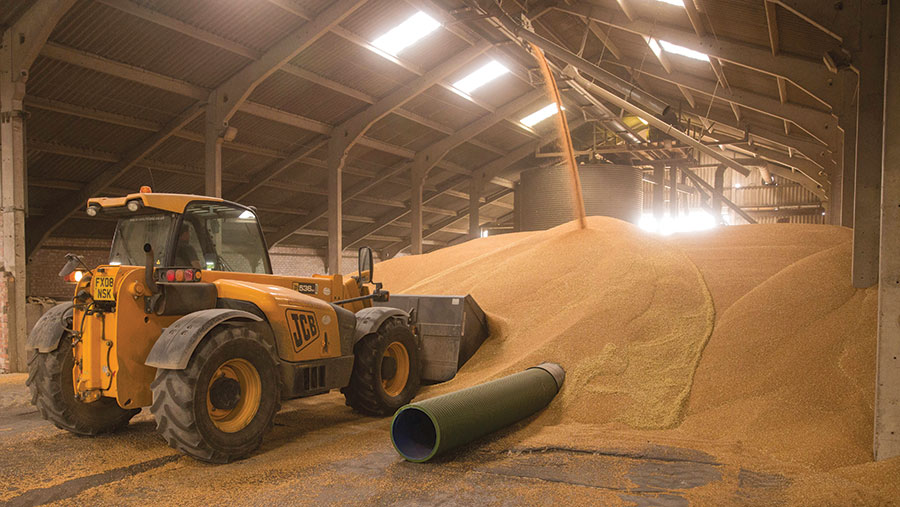Trading grain: Advice on locking in to profitable prices
 © Tim Scrivener
© Tim Scrivener Many arable farmers are not taking a rigorous enough approach to grain trading to protect themselves from losing money in volatile grain markets, say experts.
James Bolesworth, director of independent grain trading advice firm CRM Agricommodities, says that UK farmers are great at insuring themselves against yield losses in the field through the use of fungicides and fertiliser.
However, many lag behind their global counterparts in deploying a proactive strategy and using all available tools to avoid missing out on a price rally after selling, or a price drop before selling, he says.
See also: Arable finances: What to consider after tough winter
Price swings increasing
This is despite on-farm yields showing lower year-on-year deviation than grain prices, which have shown increasing volatility in the UK since 2004-05, when the US bioethanol boom contributed to a global grain shortage.
Average ex-farm wheat prices saw a 35% swing between their highest and lowest level in 2019, while on-farm yields typically move by a maximum of 20%, so growers should try to de-risk both to maximise their chances of making money, he says.
And while it is impossible to always sell at the peak, he recommends the following framework for farmers wanting to revisit their trading strategy:
Step 1: Understand the minimum selling price at which the crop is profitable
Until a grower is certain they have covered their cost of production and made a margin, they will not know if the price is right for them to trade at.
Step 2: Consider the constraints on your business that affect trading decisions
This will involve taking stock of:
- Cashflow requirements. Those with large monthly outgoings may not be able to hold back as much of their crop until late in the season.
- Storage constraints. Growers constrained by storage may be physically forced to sell more at harvest and will have less to market later on.
- Market opinion. Those with crops still to sell and a low attitude to risk may wish to sell even while prices are rising but others will be willing to wait.
A combined assessment of these factors will form the basis of a grower’s trading strategy – the decisions they make on when and how they trade their grain.
This will normally be through a combination of forward contracts, where a fixed price is agreed for a crop prior to harvest, and spot sales, where grain is traded based on the price for immediate movement.
Step 3: Familiarise yourself with volatility management tools
While trading throughout the season is in itself volatility management, as growers will normally average out the highs and lows of the market, there is more that can be done to lock in at a favourable price and be more versatile, says Mr Bolesworth.
One tool that he says is underused by UK farmers is the options market.
An option is a product that can be purchased through a broker.
It acts as insurance against a price rising or falling over a fixed period of time.
They can sometimes also be bought from a grain merchant but may cost more than buying them direct as the merchant will need a margin for managing the position, he says.
There are two types of option – call options and put options.
Call options insure against a price increasing and can therefore be useful to a grower who needs to sell their grain quickly as they will still benefit from the rising market.
Put options insure against a price falling and can be useful to protect someone who has the storage or cashflow to not sell at harvest as they believe the market will rise.
Losses are limited to the cost of the option premium if the market does not rise or fall accordingly, says Mr Bolesworth.
This is akin to insuring your car and not getting a payout because you haven’t crashed it, or applying a fungicide and then having a period of dry weather.
Trading in these products is only speculative if it is not linked to a physical transaction, and they are also used by city traders to make bets on the market rising or falling.
How it works
Purchasing put or call options gives the purchaser the right to buy or sell on a futures market of their choice at a certain price for a certain duration.
Grain is traded by farmers on futures markets around the world, including the London-based Ice Futures Europe, formally known as LIFFE, the Euronext in Paris and the Chicago Board of Trade, known as CBOT.
As ex-farm prices and futures prices track each other, a grower can use the futures market to insure a physical transaction of real grain on a spot market.
The price that you fix at is referred to as the strike price.
The cost of insuring that price is referred to as the premium.
At any time until the product expires, the buyer can “exercise” or re-sell the option and they will be paid the difference between the strike price and the futures market price on the day.
If they chose not to exercise their option before the expiry date, any payout owing to them will be automatically paid at expiry.
It is recommended that any grower who chooses to use these products closely monitors the grain markets or takes professional advice while they have active products, as they will need to decide whether to exercise their options.
However, they will already know any losses are limited to the cost of the premium, said Mr Bolesworth.
Case study: Wormell Farms
Dan Wormell, of PR Wormell Farms near Colchester, has managed risk by avoiding price falls by selling early and using options to insure against missing out on the market rising.

Dan Wormell
The 600ha farm has three flat stores, but he took the decision to lease out two of them in 2015 for rental income rather than use them for crop storage, meaning all crops had to be sold for harvest movement.
Mr Wormell worked with CRM Agricommodities to come up with a strategy that allowed the business to benefit from the diversified income without suffering from not being able to trade grain throughout the season.
Forward selling
They now forward sell up to 70% of the crop before harvest, with the rest being sold spot at harvest, but this year’s challenging weather means they have committed a lower-than-average amount so far.
He is hoping to continue trading into May and June, when spring crops have emerged, although the variability of spring wheat yield means caution will be needed.
He says: “We may lose out on a percentage in the harvest spot-price dip, but by the end of September we have sold 100% of our harvest and we have taken all downside price risk out of the marketing of the grain.
He then uses options to insure against an upswing in the market after the grain has been sold.
Get educated
“When I buy an option, I am paying an insurance premium to hedge the physical sale in case of the market rallying,” says Mr Wormell.
“You look at farmers across the world and they are using these financial tools to assist their businesses,” he says.
He says farmers should take a gain a thorough understanding of all the strategies available to their businesses.
“If they are not right for you, that’s fine, but understand them and know they are there,” he says.
“Marketing it is one of the most important things you can do – there is nothing professional about just selling grain when a merchant rings up.”
